
Heavenly Chocolates manufactures and sells quality chocolate products at its plant and retail store located in Saratoga Springs, New York. Two years ago, the company developed a web site and began selling its products over the Internet. Web-site sales have exceeded the company’s expectations, and management is now considering strategies to increase sales even further. To learn more about the web-site customers, a sample of 50 Heavenly Chocolate transactions was selected from the previous month’s sales. Data showing the day of the week each transaction was made, the type of browser the customer used, the time spent on the web site, the number of web pages viewed, and the amount spent by each of the 50 customers are contained in the file named Heavenly Chocolates. A portion of the data is shown in the table that follows:
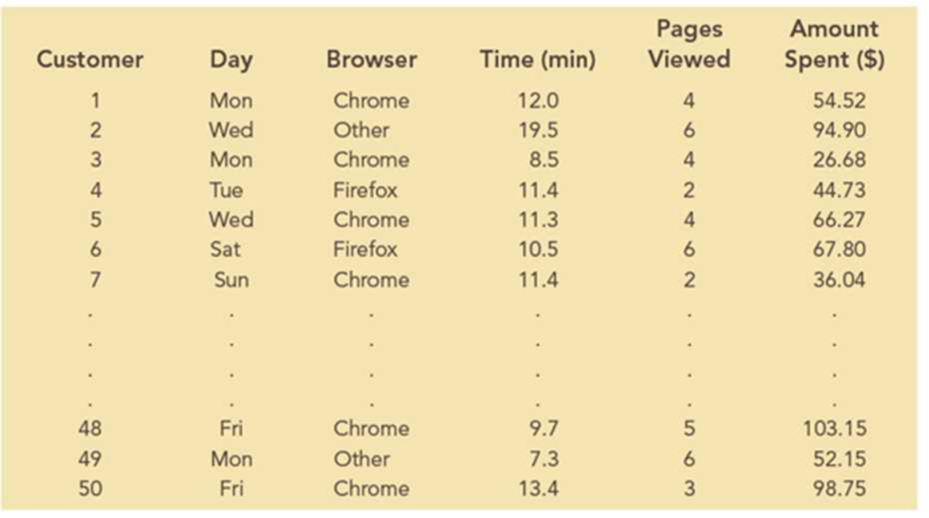
Heavenly Chocolates would like to use the sample data to determine whether online shoppers who spend more time and view more pages also spend more money during their visit to the web site. The company would also like to investigate the effect that the day of the week and the type of browser have on sales.
Managerial Report
Use the methods of
- 1. Graphical and numerical summaries for the length of time the shopper spends on the web site, the number of pages viewed, and the
mean amount spent per transaction. Discuss what you learn about Heavenly Chocolates’ online shoppers from these numerical summaries. - 2. Summarize the frequency, the total dollars spent, and the mean amount spent per transaction for each day of week. Discuss the observations you can make about Heavenly Chocolates’ business based on the day of the week?
- 3. Summarize the frequency, the total dollars spent, and the mean amount spent per transaction for each type of browser. Discuss the observations you can make about Heavenly Chocolates’ business based on the type of browser?
- 4. Develop a
scatter diagram , and compute the samplecorrelation coefficient to explore the relationship between the time spent on the web site and the dollar amount spent. Use the horizontal axis for the time spent on the web site. Discuss your findings. - 5. Develop a scatter diagram, and compute the sample correlation coefficient to explore the relationship between the number of web pages viewed and the amount spent. Use the horizontal axis for the number of web pages viewed. Discuss your findings.
- 6. Develop a scatter diagram, and compute the sample correlation coefficient to explore the relationship between the time spent on the web site and the number of pages viewed. Use the horizontal axis to represent the number of pages viewed. Discuss your findings.
1. Provide the graphical and numerical summaries for the length of time that the shopper spends on the website, the number of pages viewed, and the mean amount spent per transaction. Explain that is observed from the numerical summaries.
2. Give a summary for the frequency, the total dollars spent, and the mean amount spent per transaction for each day of week. Give interpretation.
3. Give a summary for the frequency, the total dollars spent, and the mean amount spent per transaction for each type of browser. Give interpretation.
4. Give a scatter diagram and calculate the sample correlation coefficient to explore the relationship between the time spent on the web site and the dollar amount spent. Give interpretation.
5. Give a scatter diagram and calculate the sample correlation coefficient to explore the relationship between the number of web pages viewed and the dollar amount spent. Give interpretation.
6. Give a scatter diagram and calculate the sample correlation coefficient to explore the relationship between the time spent on the web site and the number of pages viewed. Give interpretation.
Answer to Problem 1C
1. Numerical summaries:
The frequency distribution and percent frequency distribution for the length of time that the shopper spends on the website are given below:
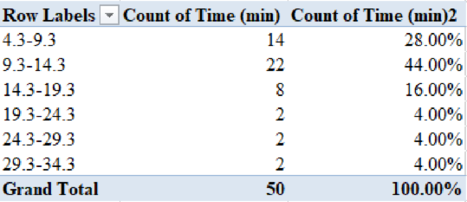
The frequency distribution and percent frequency distribution for the number of pages viewed are given below:
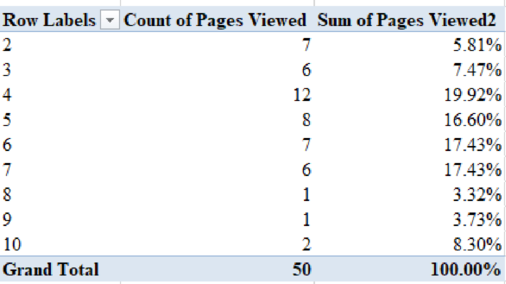
The frequency distribution and percent frequency distribution for the amount spent are given below:
The mean amount spent per transaction is obtained as 68.13.
Graphical summary:
The histogram for the length of time that the shopper spends on the website is shown below:
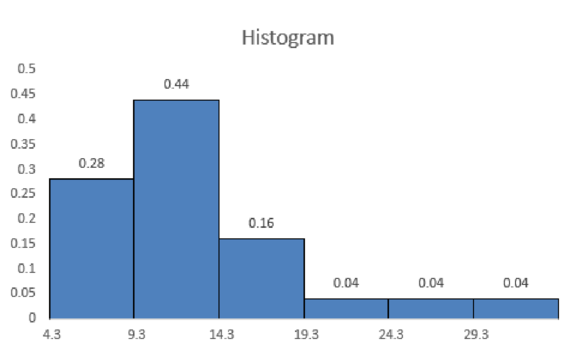
The bar chart for the number of pages viewed is shown below:
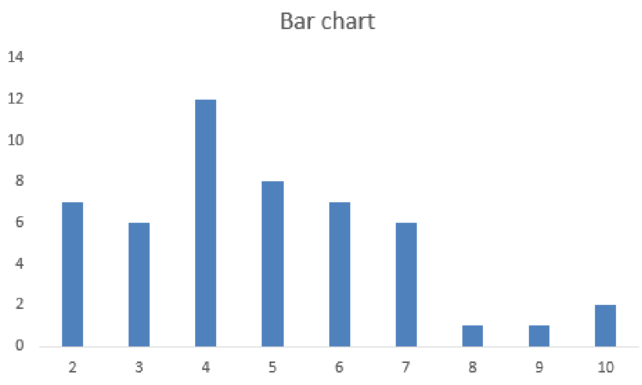
The histogram for the amount spent is shown below:
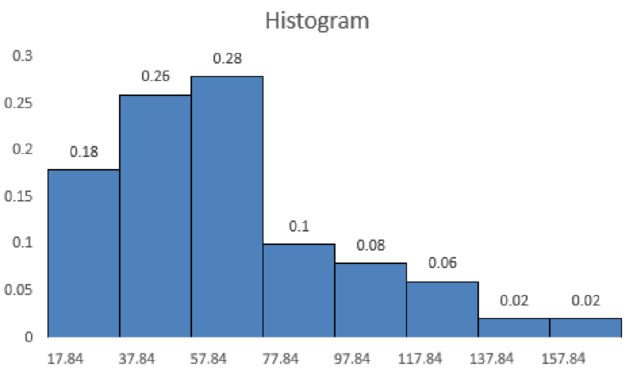
2. The frequency, the total dollars spent, and the mean amount spent per transaction for each day of week are as follows:

3. The frequency, the total dollars spent, and the mean amount spent per transaction for each type of browser are as follows:

4. The scatter diagram of the time spent on the web site and the dollar amount spent are shown below:
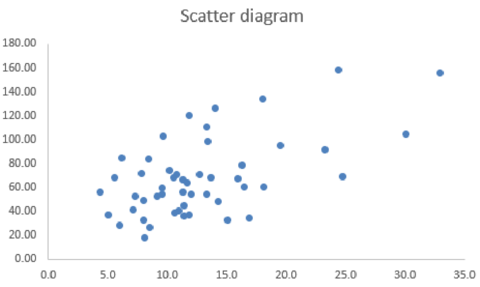
The sample correlation coefficient that explores the relationship between the time spent on the web site and the dollar amount spent is 0.58.
5. The scatter diagram of the number of web pages viewed and the dollar amount spent are given below:
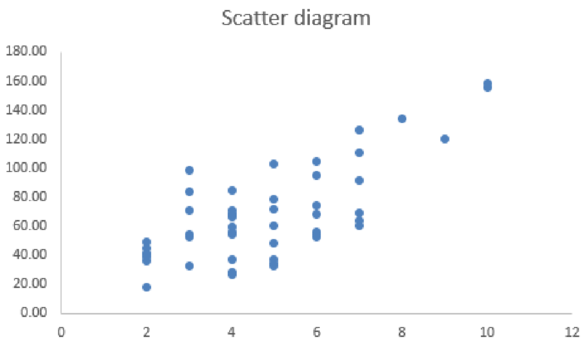
The sample correlation coefficient that explores the relationship between the number of web pages viewed and the dollar amount spent is 0.72.
6. The scatter diagram of the time spent on the web site and the number of pages viewed are shown below:
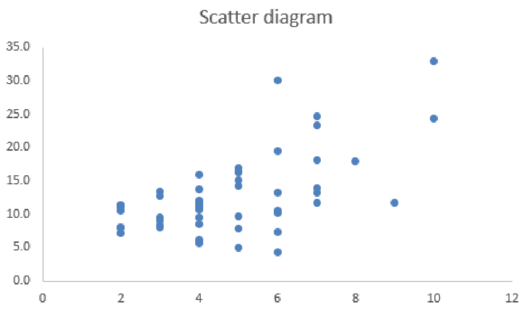
The sample correlation coefficient that explores the relationship between the time spent on the web site and the number of pages viewed is 0.60.
Explanation of Solution
1.
Numerical summary:
Step-by-step procedure to create frequency distribution and percent frequency distribution for the length of time the shopper spends on the website using an Excel:
- Select Insert > PivotTable.
- In Select a table or range, select the data of Time (min) and click OK.
- In PivotTable Fields, move Time (min) to Rows and Σ Values.
- Right click on a value from Row Labels and select Group.
- Enter 5 in By.
- Click on Time (min) from Σ Values.
- Select Value Field settings.
- In Summarize value field by, choose Count and click OK.
- Again, move Time (min) to Rows and Σ Values.
- Click on Time (min) from Σ Values.
- Select Value Field settings.
- In Show Values As, choose % of Grand Total and click OK.
Thus, the frequency distribution and percent frequency distribution for the length of time the shopper spends on the website are obtained.
Step-by-step procedure to create frequency distribution and percent frequency distribution for the number of pages viewed using an Excel:
- Select Insert > PivotTable.
- In Select a table or range, select the data of Pages Viewed and click OK.
- In PivotTable Fields, move Pages Viewed to Rows and Σ Values.
- Right click on a value from Row Labels and select Group.
- Enter 5 in By.
- Click on Pages Viewed from Σ Values.
- Select Value Field settings.
- In Summarize value field by, choose Count and click OK.
- Again, move Pages Viewed to Rows and Σ Values.
- Click on Pages Viewed from Σ Values.
- Select Value Field settings.
- In Show Values As, choose % of Grand Total and click OK.
Thus, the frequency distribution and percent frequency distribution for the number of pages viewed are obtained.
Step-by-step procedure to obtain the mean amount spent per transaction using an Excel:
- In cell F52, enter “=AVERAGE(F2:F51)”.
- Click Enter.
Thus, the mean amount spent per transaction is obtained as 68.13.
From the numerical summaries, it is clear that the highest percent frequency for length of time that the shopper spends on the website is 9.3 hours to 14.3 hours. Also, the highest percent frequency for the number of pages viewed is 4.
Graphical summaries:
Step-by-step procedure to obtain a histogram for the length of time that the shopper spends on the website using an Excel:
- Select the data of class interval and percent frequency.
- Select Insert.
- Choose Clustered Column under Charts.
- Click on a bar in the graph.
- In Format Data Series, enter Gap width as 0%.
Thus, the histogram for the length of time that the shopper spends on the website is obtained.
Step-by-step procedure to obtain a bar chart for the number of pages viewed using an Excel:
- Select the data of class interval and frequency.
- Select Insert.
- Choose Clustered Column under Charts.
Thus, the bar chart for the number of pages viewed is obtained.
Step-by-step procedure to obtain a histogram for the amount spent using Excel:
- Select the data of class interval and percent frequency.
- Select Insert.
- Choose Clustered Column under Charts.
- Click on a bar in the graph.
- In Format Data Series, enter Gap width as 0%.
Thus, the histogram for the amount spent is obtained.
2.
Step-by-step procedure to obtain the frequency, the total dollars spent, and the mean amount spent per transaction for each day of week using an Excel:
- Select Insert > PivotTable.
- In Select a table or range, select the data of Customer, Day, and Amount Spent ($) and click OK.
- In PivotTable Fields, move Day to Rows and Customer and Amount Spent ($) to Σ Values.
- Click on Amount Spent ($) from Σ Values.
- Select Value Field settings.
- In Summarize value field by, choose Sum and click OK.
- Again, move Amount Spent ($) to Σ Values.
- Click on Amount Spent ($) from Σ Values.
- Select Value Field settings.
- In Summarize value field by, choose Average and click OK.
Thus, the frequency, the total dollars spent, and the mean amount spent per transaction for each day of week are obtained.
It is clear from the output that the average amount spent on Monday is higher than other days. However, the sum of amount spent is higher on Friday. This is because the number of customers on Friday is more than the number of customers on Monday.
3.
Step-by-step procedure to obtain the frequency, the total dollars spent, and the mean amount spent per transaction for each type of browser using an Excel:
- Select Insert > PivotTable.
- In Select a table or range, select the data of Customer, Browser, and Amount Spent ($) and click OK.
- In PivotTable Fields, move Browser to Rows and Customer and Amount Spent ($) to Σ Values.
- Click on Amount Spent ($) from Σ Values.
- Select Value Field settings.
- In Summarize value field by, choose Sum and click OK.
- Again, move Amount Spent ($) to Σ Values.
- Click on Amount Spent ($) from Σ Values.
- Select Value Field settings.
- In Summarize value field by, choose Average and click OK.
Thus, the frequency, the total dollars spent, and the mean amount spent per transaction for each type of browser are obtained.
It is clear from the output that the average amount spent for Firefox is higher than other browsers. However, the sum of amount spent is higher for chrome. This is because that the number of customers using Chrome is higher than the number of customers using Firefox.
4.
Step-by-step procedure to obtain a scatter diagram of the time spent on the web site and the dollar amount spent using an Excel:
- Select the data of Time (min) and Amount Spent ($).
- Select Insert.
- Choose Scatter under Charts.
Thus, the scatter diagram of the time spent on the web site and the dollar amount spent are obtained.
Step-by-step procedure to obtain the sample correlation coefficient that explores the relationship between the time spent on the web site and the dollar amount spent using an Excel:
- In an empty cell, type “=CORREL(D2:D51, F2:F51)”.
- Click Enter.
The sample correlation coefficient that explores the relationship between the time spent on the web site and the dollar amount spent is obtained as 0.58.
It is clear that there is a positive linear correlation between the time spent on the web site and the dollar amount spent. That is, as time spent on the web site increases, the dollar amount spent also increases.
5.
Step-by-step procedure to obtain a scatter diagram of the number of web pages viewed and the dollar amount spent using an Excel:
- Select the data of Pages Viewed and Amount Spent ($).
- Select Insert.
- Choose Scatter under Charts.
Thus, the scatter diagram of the number of web pages viewed and the dollar amount spent is obtained.
Step-by-step procedure to obtain the sample correlation coefficient that explores the relationship between the number of web pages viewed and the dollar amount spent using an Excel:
- In an empty cell, type “=CORREL(E2:E51, F2:F51)”.
- Click Enter.
The sample correlation coefficient that explores the relationship between the number of web pages viewed and the dollar amount spent is 0.72.
It is clear that there is a positive linear correlation between the number of web pages viewed and the dollar amount spent. That is, as number of web pages viewed increases, the dollar amount spent also increases.
6.
Step-by-step procedure to obtain the scatter diagram of the time spent on the web site and the number of pages viewed using an Excel:
- Select the data of Time (min) and Pages Viewed.
- Select Insert.
- Choose Scatter under Charts.
Thus, the scatter diagram of the time spent on the web site and the number of pages viewed are obtained.
Step-by-step procedure to obtain the sample correlation coefficient that explores the relationship between the time spent on the web site and the number of pages viewed using an Excel:
- In an empty cell, type “=CORREL(D2:D51, E2:E51)”.
- Click Enter.
The sample correlation coefficient that explores the relationship between the time spent on the web site and the number of pages viewed is 0.60.
It is clear that there is a positive linear correlation between the time spent on the web site and the number of pages viewed. That is, as the number of pages viewed increases, the time spent on the web site also increases.
Want to see more full solutions like this?
Chapter 2 Solutions
Mindtap Business Analytics, 1 Term (6 Months) Printed Access Card For Camm/cochran/fry/ohlmann/anderson/sweeney/williams' Essentials Of Business Analytics, 2nd
- You find out that the dietary scale you use each day is off by a factor of 2 ounces (over — at least that’s what you say!). The margin of error for your scale was plus or minus 0.5 ounces before you found this out. What’s the margin of error now?arrow_forwardSuppose that Sue and Bill each make a confidence interval out of the same data set, but Sue wants a confidence level of 80 percent compared to Bill’s 90 percent. How do their margins of error compare?arrow_forwardSuppose that you conduct a study twice, and the second time you use four times as many people as you did the first time. How does the change affect your margin of error? (Assume the other components remain constant.)arrow_forward
- Out of a sample of 200 babysitters, 70 percent are girls, and 30 percent are guys. What’s the margin of error for the percentage of female babysitters? Assume 95 percent confidence.What’s the margin of error for the percentage of male babysitters? Assume 95 percent confidence.arrow_forwardYou sample 100 fish in Pond A at the fish hatchery and find that they average 5.5 inches with a standard deviation of 1 inch. Your sample of 100 fish from Pond B has the same mean, but the standard deviation is 2 inches. How do the margins of error compare? (Assume the confidence levels are the same.)arrow_forwardA survey of 1,000 dental patients produces 450 people who floss their teeth adequately. What’s the margin of error for this result? Assume 90 percent confidence.arrow_forward
- The annual aggregate claim amount of an insurer follows a compound Poisson distribution with parameter 1,000. Individual claim amounts follow a Gamma distribution with shape parameter a = 750 and rate parameter λ = 0.25. 1. Generate 20,000 simulated aggregate claim values for the insurer, using a random number generator seed of 955.Display the first five simulated claim values in your answer script using the R function head(). 2. Plot the empirical density function of the simulated aggregate claim values from Question 1, setting the x-axis range from 2,600,000 to 3,300,000 and the y-axis range from 0 to 0.0000045. 3. Suggest a suitable distribution, including its parameters, that approximates the simulated aggregate claim values from Question 1. 4. Generate 20,000 values from your suggested distribution in Question 3 using a random number generator seed of 955. Use the R function head() to display the first five generated values in your answer script. 5. Plot the empirical density…arrow_forwardFind binomial probability if: x = 8, n = 10, p = 0.7 x= 3, n=5, p = 0.3 x = 4, n=7, p = 0.6 Quality Control: A factory produces light bulbs with a 2% defect rate. If a random sample of 20 bulbs is tested, what is the probability that exactly 2 bulbs are defective? (hint: p=2% or 0.02; x =2, n=20; use the same logic for the following problems) Marketing Campaign: A marketing company sends out 1,000 promotional emails. The probability of any email being opened is 0.15. What is the probability that exactly 150 emails will be opened? (hint: total emails or n=1000, x =150) Customer Satisfaction: A survey shows that 70% of customers are satisfied with a new product. Out of 10 randomly selected customers, what is the probability that at least 8 are satisfied? (hint: One of the keyword in this question is “at least 8”, it is not “exactly 8”, the correct formula for this should be = 1- (binom.dist(7, 10, 0.7, TRUE)). The part in the princess will give you the probability of seven and less than…arrow_forwardplease answer these questionsarrow_forward
- Selon une économiste d’une société financière, les dépenses moyennes pour « meubles et appareils de maison » ont été moins importantes pour les ménages de la région de Montréal, que celles de la région de Québec. Un échantillon aléatoire de 14 ménages pour la région de Montréal et de 16 ménages pour la région Québec est tiré et donne les données suivantes, en ce qui a trait aux dépenses pour ce secteur d’activité économique. On suppose que les données de chaque population sont distribuées selon une loi normale. Nous sommes intéressé à connaitre si les variances des populations sont égales.a) Faites le test d’hypothèse sur deux variances approprié au seuil de signification de 1 %. Inclure les informations suivantes : i. Hypothèse / Identification des populationsii. Valeur(s) critique(s) de Fiii. Règle de décisioniv. Valeur du rapport Fv. Décision et conclusion b) A partir des résultats obtenus en a), est-ce que l’hypothèse d’égalité des variances pour cette…arrow_forwardAccording to an economist from a financial company, the average expenditures on "furniture and household appliances" have been lower for households in the Montreal area than those in the Quebec region. A random sample of 14 households from the Montreal region and 16 households from the Quebec region was taken, providing the following data regarding expenditures in this economic sector. It is assumed that the data from each population are distributed normally. We are interested in knowing if the variances of the populations are equal. a) Perform the appropriate hypothesis test on two variances at a significance level of 1%. Include the following information: i. Hypothesis / Identification of populations ii. Critical F-value(s) iii. Decision rule iv. F-ratio value v. Decision and conclusion b) Based on the results obtained in a), is the hypothesis of equal variances for this socio-economic characteristic measured in these two populations upheld? c) Based on the results obtained in a),…arrow_forwardA major company in the Montreal area, offering a range of engineering services from project preparation to construction execution, and industrial project management, wants to ensure that the individuals who are responsible for project cost estimation and bid preparation demonstrate a certain uniformity in their estimates. The head of civil engineering and municipal services decided to structure an experimental plan to detect if there could be significant differences in project evaluation. Seven projects were selected, each of which had to be evaluated by each of the two estimators, with the order of the projects submitted being random. The obtained estimates are presented in the table below. a) Complete the table above by calculating: i. The differences (A-B) ii. The sum of the differences iii. The mean of the differences iv. The standard deviation of the differences b) What is the value of the t-statistic? c) What is the critical t-value for this test at a significance level of 1%?…arrow_forward
 Glencoe Algebra 1, Student Edition, 9780079039897...AlgebraISBN:9780079039897Author:CarterPublisher:McGraw Hill
Glencoe Algebra 1, Student Edition, 9780079039897...AlgebraISBN:9780079039897Author:CarterPublisher:McGraw Hill Big Ideas Math A Bridge To Success Algebra 1: Stu...AlgebraISBN:9781680331141Author:HOUGHTON MIFFLIN HARCOURTPublisher:Houghton Mifflin Harcourt
Big Ideas Math A Bridge To Success Algebra 1: Stu...AlgebraISBN:9781680331141Author:HOUGHTON MIFFLIN HARCOURTPublisher:Houghton Mifflin Harcourt Holt Mcdougal Larson Pre-algebra: Student Edition...AlgebraISBN:9780547587776Author:HOLT MCDOUGALPublisher:HOLT MCDOUGAL
Holt Mcdougal Larson Pre-algebra: Student Edition...AlgebraISBN:9780547587776Author:HOLT MCDOUGALPublisher:HOLT MCDOUGAL


